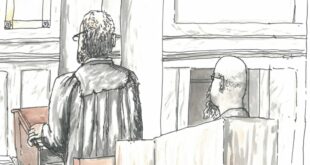Sgt. Arthur Melvin enlisted in Calgary, was buried as 'unknown soldier' in France

The family of a soldier who joined the Canadian Army in Calgary and served in the First World War say it's difficult to explain how important it is to learn that his grave has finally been identified.
"It was just incredibly emotional," said Stuart Neilson, who works as a police officer in Scotland.
"He's laid there for 106 years. I can't get my head around that. His mom and dad are my great-great-grandparents. And I just wish they knew that we'd taken the time [to find him]."
Sgt. Arthur Melvin is Neilson's great-great uncle. Neilson, along with his aunt, has been researching Melvin's life for many years.
But he never knew the full story until now. Though the family dove deep into its history and conducted its own research, Neilson said it was just a "tiny part" compared to the "phenomenal" efforts of a team within the Canadian Department of National Defence.
On Tuesday, the Department of National Defence and the Canadian Armed Forces announced that the grave of a Canadian soldier of the First World War had been identified. Melvin's grave was confirmed to be in Bois-Carré British Cemetery, in Thélus, France.
The search
The process of identifying grave cases involves researching historical documentation to assign names to unidentified individuals, without additional help from remains.
After checking archives and scouring documents, researchers submit a report to the Casualty Identification Review Board, which must vote unanimously in order to accept the identification.
"The challenge that we had with this particular one was the location, simply because [Melvin] was ultimately part of the Battle of Arras [in spring of 1917]. It's a very huge Canadian offensive," said Renée Davis, a historian of military heritage at the Directorate of History and Heritage.
"He's in an area where there is a tremendous amount of fighting, and the village where he ultimately lost his life was overrun."
The Battle of Vimy Ridge, which was a part of the Battle of Arras, saw many Canadian casualties, and therefore many missing Canadian soldiers.
But Davis said partial identifiers on his headstone in Bois-Carré British Cemetery indicated he was an unknown sergeant of the 31st Battalion, with a date of death of April 9, 1917. Melvin was the only sergeant from that battalion missing on that date with no known grave.
All the archival documentation, including personnel files, casualty cards, war diaries and other documents, pointed to it being him in the grave, and could not be anyone else, Davis said.
"The documentation showed that Sgt. Melvin had been hit by a shell during the battle in the village of Thélus and was buried as one of the original graves at the cemetery in the aftermath of the assault," she said in an email.
"We don't know why he wasn't identified at the time, but there was enough historical evidence to identify him now."
Enlisted in Calgary
Melvin was born on June 3, 1887, in the small Scottish village of Udny, in Aberdeenshire, to James and Helen Melvin. He lived in Aberdeenshire with nine siblings before immigrating to Canada sometime after 1901.
He initially worked as a pipefitter before he enlisted with the 56th Infantry Battalion, Canadian Expeditionary Force (CEF), on May 18, 1915, in Calgary.
READ | The attestation paper, signed by Arthur Melvin in Calgary in 1915:
On his arrival with the 56th, Melvin would have started by being issued a uniform. The joke at that time was that there were only two sizes — too big and too small, said Kent Griffiths, the curator for the Calgary Highlanders, the group which perpetuates the 56th Battalion.
"He probably would have gotten a woolen, itchy uniform that was a little bit too big, and a pair of boots," Griffiths said. "He would be gathered with other men of his age until there was enough to send them off for training."
The 56th, a reinforcement battalion, drew young men from the Calgary area before sending them off to reinforce other battalions already fighting in the First World War.
He was transferred to the 31st Infantry Battalion and sailed for England. As a part of the 31st, he was trained in how to conduct operations from trenches.
He was then sent to France, where he was stationed in a trench for roughly 100 days.
It rained for around 75 of those days, and the soldiers had to contend with the mud, the rain and the vermin — rats as well as lice, said Wes Krause, curator of the South Alberta Light Horse museum.
"It was not easy for the Canadian Expeditionary Force during World War I," Krause said, adding that CEF was a highly-trained force that was respected by Allied forces in France.
During the Battle of Vimy Ridge, the 31st Infantry Battalion was assigned a portion of the ridge to take possession of. They would move through the trenches, across open field and through barbed wire entanglements, facing the German machine guns, in order to take their objectives, Krause said.
The battalion took heavy losses. Of the initial 1,000 or so men who made up the regiment, 941 died.
There were more than 2,300 non-fatal injuries en route to the battalion's ultimate goal, Krause said.
"That was to, basically, bring the end of World War I, secure Europe and France, and protect it from the Germans," he said.
Ceremony will come in near future
In cases such as this, those soldiers who have been discovered will get the funerals they deserve, Griffiths said.
That will be the case for Melvin, whose headstone will be rededicated in a ceremony at the earliest opportunity, National Defence says.
There are small teams who complete this sort of work, particularly in Canada, said Davis, the military heritage historian.
"It is a team effort, in order to give Sgt. Melvin his name back," she said.
For Melvin's remaining family, those efforts don't go unnoticed. Neilson said he and his family would like to attend the ceremony after details are finalized.
"I wonder what he would say if he knew what all these people had done for him. And that makes me a wee bit proud, that we've done that," he said.
ABOUT THE AUTHOR
Joel is a reporter/editor with CBC Calgary. In fall 2021, he spent time with CBC's bureau in Lethbridge. He was previously the editor of the Airdrie City View and Rocky View Weekly newspapers. He hails from Swift Current, Sask. Reach him by email at joel.dryden@cbc.ca
With files from Carolyn Dunn
*****
Credit belongs to : www.cbc.ca
 MaharlikaNews | Canada Leading Online Filipino Newspaper Portal The No. 1 most engaged information website for Filipino – Canadian in Canada. MaharlikaNews.com received almost a quarter a million visitors in 2020.
MaharlikaNews | Canada Leading Online Filipino Newspaper Portal The No. 1 most engaged information website for Filipino – Canadian in Canada. MaharlikaNews.com received almost a quarter a million visitors in 2020.







